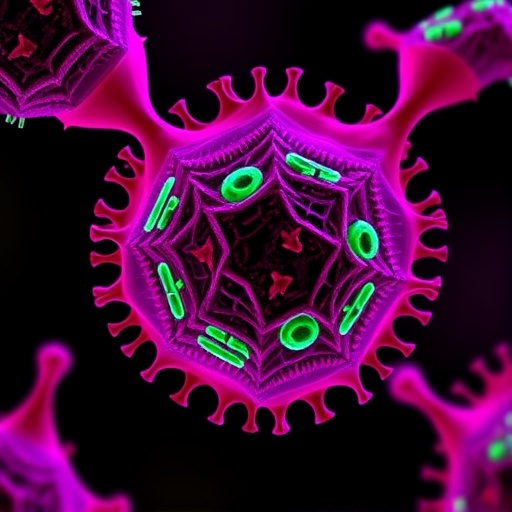A groundbreaking study led by researchers at Xinjiang Medical University has unveiled a novel keratinocyte subpopulation linked to early-stage cervical squamous cell carcinoma (CESC) driven by human papillomavirus (HPV) infection. Utilizing cutting-edge single-cell RNA sequencing (scRNA-seq) alongside multiplex immunohistochemistry (mIHC), the team meticulously mapped the cellular and molecular landscape of HPV-positive cervical tumors, identifying a distinct group of keratinocytes characterized by the expression of PI3 and S100A7. This discovery sheds light on the cellular heterogeneity within tumors and offers profound insights into the pathological interplay governing cervical carcinogenesis.
Cervical squamous cell carcinoma remains a critical global health challenge, predominantly caused by persistent infection with high-risk HPV strains. Despite advancements in screening and vaccination, understanding the early molecular events leading to malignant transformation has been limited. In this context, the Xinjiang cohort’s scRNA-seq profiling has delineated keratinocyte subpopulations directly associated with HPV presence, marking a significant leap forward in characterizing the tumor microenvironment’s (TME) complexity.
Through rigorous sequencing of both tumor and adjacent normal cervical tissues from early-stage CESC patients, the investigators identified keratinocytes with high co-expression of PI3 and S100A7 as being disproportionately enriched within the tumor compartment. These PI3+S100A7+ keratinocytes exhibited transcriptional signatures denoting activated oncogenic pathways, including NF-κB and TNF signaling cascades, which are crucial mediators of inflammation and tumor progression. The pronounced expression of cytokine-receptor interaction genes within this subset underlines their role in orchestrating local immunological dynamics.
Spatial transcriptomic analysis and immunohistochemical validation revealed that these keratinocytes are frequently localized in proximity to CD163+ tumor-associated macrophages (TAMs). This juxtaposition suggests a bidirectional crosstalk wherein keratinocytes and macrophages co-activate signaling networks that facilitate tumor growth, promote invasion, and potentially aid immune evasion. These interactions encompass key chemokines and cytokines such as CCL2, CXCL8, and IL-10, which modulate macrophage recruitment and polarization, thus reshaping the immune milieu within the TME.
Intriguingly, the prognostic implications of PI3+S100A7+ keratinocyte infiltration were substantiated using The Cancer Genome Atlas (TCGA) data, wherein elevated presence correlated with significantly worse patient survival outcomes. Patients exhibiting high concurrent infiltration of both these keratinocytes and CD163+ macrophages showed the most pronounced decrease in overall survival, underscoring the clinical relevance of this cellular interplay.
Further dissecting stromal components, the study identified four fibroblast subtypes within tumor versus adjacent tissues. Among these, cancer-associated fibroblasts (CAFs) manifesting an inflammatory phenotype (C1 subtype) were predominantly expanded in tumor regions. These CAFs activated pathways that may synergize with keratinocyte-macrophage signaling to foster a pro-tumorigenic extracellular matrix and facilitate malignant progression, whereas undifferentiated fibroblasts (C3 subtype) mainly resided in non-cancerous tissues, indicating distinct stromal remodeling patterns.
Professor Ruozheng Wang, principal investigator, emphasized the dual significance of PI3 and S100A7, noting their marked overexpression in HPV-driven cervical cancer samples relative to normal controls. Immunohistochemistry not only confirmed co-localization but delineated a clearly defined keratinocyte subpopulation contributing uniquely to tumor biology. This finding advances the understanding of HPV-induced transcriptional reprogramming at the cellular level.
Moreover, the study underlines macrophages as key effectors modifying the TME through their enriched presence and potent crosstalk with keratinocytes mediated by pro-inflammatory and immunosuppressive factors, such as tumor necrosis factor (TNF) and interleukin-10 (IL-10). This milieu likely facilitates viral persistence and promotes early oncogenic transformation, posing challenges for immune clearance.
The intricate dialogue between HPV-infected keratinocytes and immune cells as revealed by this work highlights the dynamic remodeling of the tumor microenvironment, where viral oncogenesis intertwines with immune modulation and stromal reprogramming. This multifaceted interplay orchestrates an environment conducive to malignant initiation and progression, providing novel avenues for therapeutic intervention.
Importantly, this research advocates for targeting the identified signaling pathways and cell populations therapeutically. Inhibitors or immunomodulatory agents specifically designed to disrupt keratinocyte-macrophage communication or CAF activation could provide transformative strategies to halt or reverse early cervical cancer progression, marking a paradigm shift toward precision oncology.
This study not only enriches the molecular understanding of HPV-driven cervical carcinogenesis but also underscores the potential of single-cell technologies to unravel cellular heterogeneity and complex intercellular interactions within tumors. By pinpointing critical players like PI3+S100A7+ keratinocytes, it sets the groundwork for future diagnostics and targeted therapies demanding early-stage intervention.
In conclusion, the identification of this keratinocyte subtype reshaping the tumor microenvironment through crosstalk with immune and stromal elements opens new research frontiers. It paves the way for precise molecular targeting in early cervical squamous cell carcinoma and exemplifies how integrating high-resolution single-cell methodologies can revolutionize cancer biology and patient care.
Subject of Research: Cells
Article Title: Single-cell analysis identifies PI3+S100A7+ keratinocytes in early cervical squamous cell carcinoma with HPV infection
News Publication Date: 20-Oct-2025
Web References: Chinese Medical Journal article
References: DOI: 10.1097/CM9.0000000000003795
Image Credits: Professor Ruozheng Wang from The Affiliated Tumor Hospital of Xinjiang Medical University
Keywords: Cervical cancer, Oncology, Tumor microenvironments, Keratinocytes, Single cell sequencing, Immunology, Molecular biology, Gene expression, Biomarkers
Tags: cervical cancer global health challengeearly-stage cervical squamous cell carcinomaHPV infection and cancer progressionHPV-linked cervical cancer researchmultiplex immunohistochemistry in oncologynovel keratinocyte subpopulation identificationoncogenic pathways in cervical cancerPI3 and S100A7 expression in tumorssingle-cell RNA sequencing in cancertumor microenvironment cellular heterogeneityunderstanding malignant transformation in HPV-positive tumorsXinjiang Medical University research study





